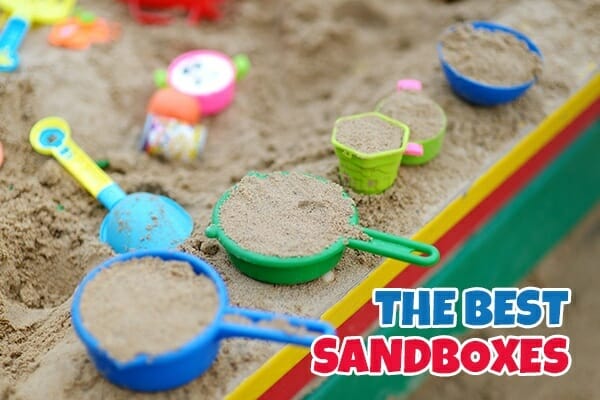Top 10 Best Sandboxes for Toddlers – 2021 Reviews
Do you have fond memories of playing in a sandbox as a child? They’re classic toys for a reason. Sandboxes are a great way for kids to have fun outdoors. Plus, playing in sand helps kids develop physically, cognitively, and emotionally.
Although sandboxes all have a relatively simple design, quality can vary considerably from brand to brand. Not sure what type of sandbox is best, and what features your kids will enjoy? Here are 2021’s ten best sandboxes for kids plus a guide with everything you need to know:
Quick Picks: The Top 3 Best Sandboxes for Toddlers
Contents
- Best Sandboxes of 2021
- Step2 Naturally Playful Sand Table
- Little Tikes Turtle Round Sandbox
- KidKraft Cabana Sandbox
- Costzon Kids Cabana Sandbox
- Hexagon Wooden Sandbox by Creative Cedar
- Step2 Naturally Playful Sandbox II
- Little Tikes Big Digger Sandbox
- KidKraft Backyard Sandbox
- Step2 Naturally Playful Sand & Water Center
- Badger Basket Covered Cedar Sandbox
- Should I Buy a Sandbox or Make My Own?
- What are the Different Types of Sandboxes?
- Plastic
- Wood
- What are the Different Features?
- Size
- Cover
- Canopy
- Seats and Benches
- Toys
- What are the Benefits of Playing in a Sandbox?
- Physical Benefits
- Social Benefits
- Creative Benefits
- What Age Can Children Safely Play in a Sandbox?
- How Do I Clean the Sandbox?
- Spot Cleaning
- Whole Sandbox Cleaning
- How to Place a Sandbox
- Final Thoughts
Best Sandboxes of 2021
Step2 Naturally Playful Sand Table
Step2’s elevated sand table has a unique, toddler-friendly design which keeps the sand clean and dry.
Pros
- The elevated table is the perfect size for toddlers
- Sturdy plastic design holds 40 pounds of sand
- Includes protective cover with elastic straps
Cons
- Relatively small side (best for one or two kids)
Our favorite sandbox, especially for toddlers, is Step2’s Naturally Playful Sand Table. It’s an elevated table, so little ones can stand while they play. By elevating the play area, the sand stays clean and dry.
The table stands 16 inches tall. It’s 36 inches wide by 26 inches long. The sand bowl varies from 2.5 to 3.5 inches deep. It’s made with sturdy plastic with a tan, faux-wood style. It holds 40 pounds of sand.
A protective lid fits snugly into the molded grooves, while an elastic strap keeps it secure from neighborhood animals. Plus, the top of the lid has molded lines which form a racetrack for toy cars.
Aside from the table, the set includes two shovels, two claw rakes, and a bucket.
Little Tikes Turtle Round Sandbox
This classic Turtle-shaped sandbox features a protective lid, built-in seats, and durable construction.
Oops! Looks like this toy is sold out.
Pros
- Timeless turtle-shaped design
- Includes shell-shaped cover
- Lightweight and easy to move
- Durable plastic construction
- Holds 50 – 150 pounds of sand
Cons
- The cover doesn’t have straps
- Plastic is thin at the top of the shell
Turtle-shaped sandboxes have been around for decades; you might have even played in one yourself as a child. This version from Little Tikes features the classic style while adding several contemporary features including molded-in seats and ergonomic design.
The turtle’s shell is a tight-fitting protective cover which keeps out water and animals. At 45 inches long by 29.25 inches wide, it’s large enough for two toddlers to play together. Without sand, it weighs a lightweight 16 pounds.
KidKraft Cabana Sandbox
With mesh windows and an arched canopy, the Cabana Sandbox from KidKraft protects kids from sun, wind, and insects.
Pros
- Mesh walls and canopy block sun and rain
- Includes three large storage bins
- Protects against insects
- Made from stylish, weather-resistant wood
Cons
- Doesn’t keep out heavy rain
- Animals can get inside without much effort
KidKraft’s Cabana Sandbox adds an extra layer of protection with a lightweight canvas roof and three walls (two with mesh windows). It protects against direct sunlight, wind, and rain. You can even unroll the fourth all-mesh wall to enclose the sandbox, protecting little ones from bugs completely.
The total size is 48.3 inches high by 57 inches wide with about four square feet of sandbox space inside. Plus, the interior has three storage bins for toys and other gear. The weather-resistant outdoor wood is a stylish dark brown.
However, this probably isn’t the best sandbox if you live in an area with tons of rain. While it’s rain resistant, the mesh sides won’t keep out any heavy downpour. Also, the canvas walls aren’t terribly secure against wildlife.
Costzon Kids Cabana Sandbox
An all-natural look combined with a sun-blocking canopy make this sandbox a beautiful, safe choice for any backyard.
Oops! Looks like this toy is sold out.
Pros
- Features a large, colorful canopy
- Includes two built-in benches
- Quality fir construction
Cons
- Instructions can be difficult to follow
- Cover is thin
Made from beautiful, heavy-duty fir, Costzon’s Cabana Sandbox adds all-natural style to any backyard. The box features two bench seats and a large blue canopy. The benches have a total weight capacity of 200 pounds and fold flat to create a cover.
The sandbox has what’s called bottomless construction. You can excavate your lawn within the perimeter of the benches. Basically, the sandbox can be as deep as you want.
Hexagon Wooden Sandbox by Creative Cedar
Simple and elegant, this six-sided sandbox includes seat boards, a cover, and more.
Pros
- Sturdy, six-sided sandbox
- Includes custom cover
- Includes seat boards
- Handsome treated cedar construction
Cons
- The cover doesn’t fit very precisely
Although it’s not packed with features, there’s a simple elegance to this sandbox from Creative Cedar Designs. It’s made with treated cedar timbers with a green cover and ground liner. The total weight limit for the sand is 500 pounds.
It’s 59 inches long by 51 inches wide with nine-inch sides. Two toddlers can play together without crowding. The benches fit kids as well as parents who want to sit close and supervise.
Step2 Naturally Playful Sandbox II
Step2’s castle-shaped sandbox has enough room for two and includes seven fun tools.
Pros
- Stylish design with faux-stone
- Includes one-piece lid
- Includes seven high-quality sand toys
Cons
- Difficult assembly requires your own tools
With a tan, faux-stone exterior, Step’s Sandbox II looks right at home in any backyard. It’s a rectangular sandbox 31 inches wide, 50 inches long and 16 inches deep. It holds up to 200 pounds of Play Sand.
The custom lid features a subdued sun design. But the toys are the main feature here. You get seven total including a rake, sifter, castle mold, buckets and more.
Little Tikes Big Digger Sandbox
Junior hardhats will love this construction-themed set with multiple vehicles from Little Tikes.
Pros
- Sandbox includes excavator and truck toys
- Plastic design is durable and colorful
- Includes built-in cover
- Cover folds out into a ramp for the toy truck
Cons
- Construction theme won’t be interesting to every kid
This sandbox playset helps kids build their imaginations. The included excavator scoops up sand and drops it into the back of the toy dump truck. The set also includes a variety of toy rakes, buckets, and other fun tools.
The secure lid unfolds into a molded ramp for the dump truck toy. All materials are made from durable, colorful plastic. It’s a unique set which fans of toy trucks are sure to love.
The set is 28.5 inches long, 51 inches wide and 25 inches high (the height of the excavator). It holds 100 pounds of play sand.
KidKraft Backyard Sandbox
A large, sturdy sandbox made from weather-resistant wood with an easy-to-use mesh cover.
Pros
- Made from reinforced, weather-resistant wood
- Large size sandbox with built-in benches
- The mesh cover is quick and easy to apply
Cons
- Requires rather complicated assembly
- Mesh cover doesn’t protect against wet weather
KidKraft’s Backyard Sandbox has the benefits of a wooden sandbox but without many of the drawbacks. The reinforced wood panels resist warping due to heavy water exposure. It’s a good choice if you live in a rainy area but want a wooden sandbox.
Also, it’s large and solid. Built-in seating allows parents and kids to sit while they play. Two or possibly three toddlers can play at the same time comfortably.
Instead of a solid cover, the sandbox has a mesh one. While that keeps out animals, you’ll likely need a second cover to keep out water.
Step2 Naturally Playful Sand & Water Center
Combine sand and water with this two-part play table. Step2
Pros
- The table features separate water and sand sections
- The water section has a plug for easy draining
- The sand section holds up to 20 pounds of sand
- Includes sand toys, toy boats, an umbrella and more
Cons
- Water section requires draining after every play session
Step2’s play table is divided into two sections for sand and water. Kids can play and experiment with the different textures sand has when wet. The table holds up to 20 pounds of sand while the water side has a drain plug for easy draining. The table includes eight toys, a 60-inch removable umbrella, two bridges, two boats and more.
A one-piece plastic cover keeps the sandbox clean when not in use. Elastic tie-downs keep the cover securely attached. Even nimble animals like raccoons won’t be able to remove it.
Badger Basket Covered Cedar Sandbox
A beautiful, weather-resistant cedar sandbox with a large canopy and bottomless construction.
Pros
- Cedar wood construction is durable and stylish
- Sandbox includes a canopy and two benches
- Heat-treated wood can withstand harsh weather
- Bottomless design allows for a deep sandpit
Cons
- Doesn’t include a cover
- Bottomless sandbox requires extra sand
Add classic style to your backyard with this stained cedar wood sandbox. It features benches and a large canopy. Designed to last for a long time even after regular exposure to harsh weather, the wood is heat-treated and rust-resistant.
It’s a bottomless sandbox, which does have pluses and minuses. While you can customize the depth of the sand, you might also have to refill it more than a box with a traditional floor.
Should I Buy a Sandbox or Make My Own?
The basic structure of a sandbox is simple and straight-forward. Technically, you only need four walls and a floor. Some people decide to make a sandbox on their own. While this does let you design the sandbox however you like, there are a few potential pitfalls to a D.I.Y. sandbox.
Making your own sandbox does require a moderate level of carpentry skills. You need to know how to attach boards securely to keep the sand inside the box. The wood should be sanded and varnished to prevent kids from getting splinters. You’ll also need to build any accessories you might want, such as a cover, benches, or storage bins.
Unless you’re a master carpenter, you’re probably better off buying a pre-made sandbox. The quality will almost certainly be superior. Plus, your sandbox can have many much-needed accessories.
What are the Different Types of Sandboxes?
Sandboxes are either made from plastic or wood. One type isn’t clearly better than the other. They both have different benefits (and drawbacks):
Plastic
Plastic sandboxes are the most popular type. They’re lightweight, easy to keep clean, and generally don’t require much maintenance.
Generally, a plastic sandbox will last a long time. They’re difficult to dent or permanently damage. Plus, a damp cloth is all you need to keep the exterior clean.
They’re also the most waterproof type. Wooden sandboxes are assembled from different pieces of wood, but plastic ones are molded, so they typically have no seams or corners. Also, wood will often fade and warp after consistent exposure to water, while plastic is more resilient.
However, plastic can get a lot hotter than wood. On hot days, the plastic can even become too hot to touch! Plus, prolonged sunlight exposure can fade the colors of a plastic sandbox over time.
Plastic sandboxes are the best choice:
- If you live in a wet or humid area
- If you frequently move the sandbox around the yard
- If you want the most durable construction
But you might want to avoid plastic if you live in an area which is often very hot and dry. Also, a plastic sandbox might not fit in with your existing backyard décor.
Wood
Wooden sandboxes aren’t quite as common as plastic ones, but they’re still very popular. Wooden sandboxes are stylish, eco-friendly, and they typically stay cool in direct sunlight.
Wooden sandboxes can be quite large, usually much larger than plastic ones. Plus, with proper care, wooden sandboxes can last for many years.
Although wood can certainly become hot in direct sunlight, it rarely gets as dangerously hot as plastic. Also, wooden sandboxes have no chemicals or paint which can leach into the sand or ground. (However, non-toxic ABS plastic is equally safe as wood in this regard.)
On the downside, wood requires more maintenance than plastic. It should be washed with soap and water. Also, you’ll need to check the sandbox fairly frequently for splinters, loose screws and other potential hazards.
Also, wood is more susceptible to weather damage. Rain and snow can warp, crack, and fade the wood over time.
Wooden sandboxes are the best choice:
- If you live in a mild, dry climate
- If you want a large sandbox or one with a unique design
- If you want the sandbox to fit in with your existing backyard furniture
But wooden sandboxes can be damaged if you live in a wet or snowy climate.
What are the Different Features?
Despite the name, it’s more than just a box of sand. Sandboxes have a few different features you’ll want to consider when selecting the best one for your family:
Size
The size of your sandbox depends on the size of the yard or outdoor playset where you plan to place it. Ideally, it should be large enough so all your children can play together.
Large sandboxes are also a good choice for younger children who need adult supervision. Mom or dad can sit inside a large sandbox and play with the little ones.
Of course, sandboxes need to be filled with sand. Filling a large sandbox can be quite a chore, requiring many bags of play sand. We’ll discuss filling details later, but keep in mind larger sandboxes do require more work to maintain.
Cover
Your sandbox needs a cover. Most sandboxes include covers with a custom fit. Usually, the cover slides into grooves on the top of the sandbox walls. Many sandboxes will also have an elastic strap or cord which additionally secures the cover.
Always keep the sandbox covered when not in use. The cover keeps out wild animals, neighborhood cats, bugs and other creatures. Also, the cover prevents the sandbox from filling with water in a rain or snowstorm. Finally, the cover keeps the wind from blowing sand all over your yard.
Quality sandboxes include a custom cover. However, you can also make a simple cover from a piece of wood. While it won’t fit as tightly as a custom cover, a homemade cover will still deter animals and help keep the sand dry.
Canopy
A canvas canopy or umbrella helps blocks hot sunlight and dangerous UV rays. It’s a great accessory for protecting kids when the sandbox is in the sun’s path. Plus, it keeps the sand cool.
Downsides to a canopy are relatively minor. You want to make sure any poles are secure and lightweight, just in case the canopy should tip over. Also, a canopy can potentially blow away in windy weather.
Seats and Benches
Many sandboxes have built-in seats or benches. They make play more comfortable when the sand is hot, damp, or wet. Also, many adults prefer to sit on a seat when playing in the sand with kids.
Built-in seats are generally pretty safe, but you’ll want to watch out for two potential problems. Plastic seats quickly heat up enough to burn skin. Wooden sets can develop splinters and jagged edges. However, as long as you check out the seats before kids start playing, there’s typically not much to worry about.
Toys
Many sandboxes include accessories such as buckets, rakes, and other kid-friendly beach tools. Generally, plastic toys are the safest option. You’ll want to avoid metal toys, especially for use by younger kids.
Although not incredibly common, some sandboxes include built-in storage compartments. While they can be a handy way to keep toys organized, they’re not strictly necessary as long as the sandbox has a cover.
Are you looking for great sandbox toys? Our 2021 guide to the Best Beach Toys is a great resource.
What are the Benefits of Playing in a Sandbox?
Sandbox play seems simple, but it provides tons of different benefits:
Physical Benefits
Sandbox play helps with muscle development. Playing with sand involves lots of pushing, scooping, digging, and lifting. It helps develop a wide range of upper-body muscles.
Also, building sand castles and other creations often requires precise physical coordination. Sand play often helps develop fine motor skills.
Finally, sand helps with tactile development. Sand changes texture based on temperature and water saturation. Kids love to explore its ever-changing consistency and feel.
Social Benefits
Large sandboxes encourage collaborative play. Kids often quickly discover they can build bigger, better creations when they work together.
Additionally, sand’s unique structure means accidents are likely to happen. Castles and other creations can slide apart over time. Kids learn how to be careful – and also how to be forgiving of mistakes.
Note: Even though the family dog or cat is often considered a friend, they should never be allowed inside the sandbox. Small grains of sand can cause irritation and other problems for domestic animals.
Creative Benefits
Sand helps build imaginations. It’s a versatile substance which allows kids to flex their creative muscles. The sandbox can become a medieval countryside, alien landscape, and much more. It allows for independent, unstructured play.
What Age Can Children Safely Play in a Sandbox?
Generally, sandboxes are safe for even young kids. Most parents introduce their kids to sandbox play between 12 and 18 months. But with close supervision, even younger kids can enjoy playing in the sand.
The two biggest potential hazards associated with sandboxes are:
- Hot surfaces
- Eating the sand
As discussed above, plastic materials typically get much hotter than wood ones. But, as a parent, you’ll want to check the surface temps of any sandbox before allowing your kids inside. Press the back of your hand to the box and sand to test its suitability for play.
Also, teach kids not to put sand in their mouths. Truthfully, sterilized, fresh play sand isn’t particularly dangerous. However, sand becomes potentially hazardous when exposed to weather and animals, especially animal feces.
Keeping the sandbox covered when not in use helps decrease the level of bacteria. Additionally, make sure kids wash their hands thoroughly when they’re done playing.
Don’t cover the sandbox if the sand is wet. Instead, allow it to dry completely. Moving the sandbox into direct sunlight (when possible) helps speed the drying process. Raking the sand can help it dry faster, too.
Rake the sand frequently. Raking helps keep it clear from clumps and objects. You’ll want to rake the sandbox before every play session.
How Do I Clean the Sandbox?
There are two types of cleaning:
- Spot cleaning for specific areas
- Entire box cleaning
Spot Cleaning
Sooner or later, it’s bound to happen: an animal has pooped in the sandbox. Neighborhood cats, foxes, raccoons, and other critters love to leave feces in sand.
Fortunately, you can spot clean the area and make the sandbox safe for play without a complete sand change.
The first step – of course – is to remove the feces from the sandbox. Actually, this isn’t as gross as you might think, because the sand basically acts like cat litter. You might want to keep a cat litter scooper handy for this purpose.
Next, you’ll need to create a disinfecting spray. Mix equal parts bleach and water. Then spray the mixture all around the area, including the sides of the box.
Turn the sand repeatedly while you spray. Mix up the top and bottom layers as best as possible. Continue until the entire area is saturated.
Let the sand dry, ideally in the sun, for at least 30 minutes. Rake the sand to make sure it’s dried all the way through to the bottom.
A spot cleaning is ideal for cleaning up a small amount of feces from an animal or leaky diaper.
Whole Sandbox Cleaning
You’ll want to completely change out the sand at least once a year.
When the sandbox is empty, clean it thoroughly with the 50/50 bleach and water mixture from above. It’s also a good time to check the box for any signs of leaks or damage.
Only use Play Sand. Avoid beach sand, crushed minerals, and other types of sand. Play sand has a unique fine grade. Plus, it’s been washed, dried, and screened.
Replacing the sand can be a hassle. If you have a large sandbox, look into buying a bulk amount of play sand for delivery. Even though it might be more expensive than buying individual bags of sand from the store, you can save a lot of time and effort.
How to Place a Sandbox
First, consider the size of the backyard or play space where you plan to place the sandbox. How much sunlight directly touches the sandbox throughout the day? You’ll want to keep it out of direct sunlight as much as possible.
Also, consider cleaning. You’ll need to empty the sandbox and refill it at least once a year. Make sure you don’t have to lug bags of sand across your yard needlessly.
Final Thoughts
Playing in sand isn’t just fun; it’s educational, too! Kids as young as one can safely enjoy time spent in the sandbox. Plus, sandboxes are easy to set up and affordable. Add a sandbox to your backyard today, and your kids will have fun for years!




















